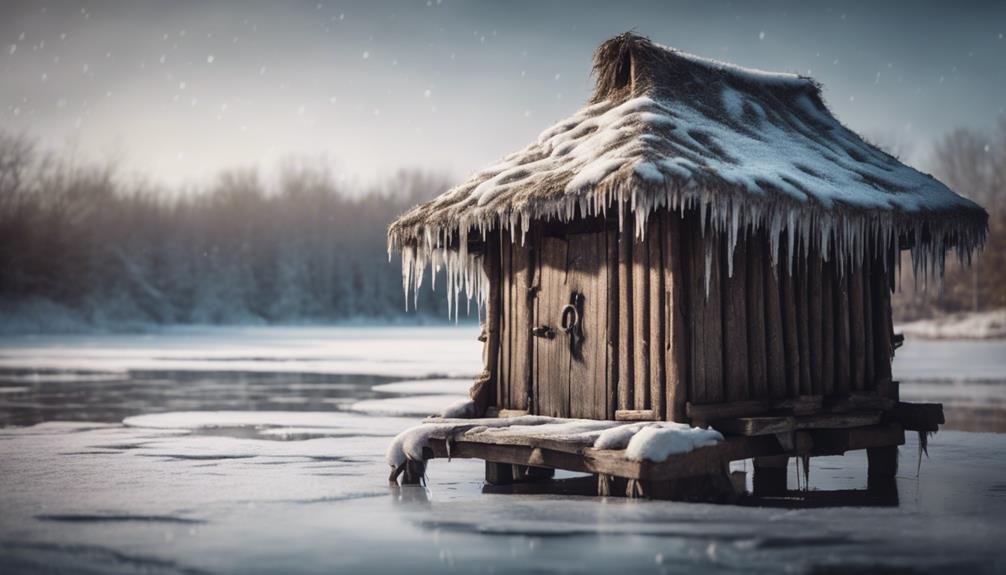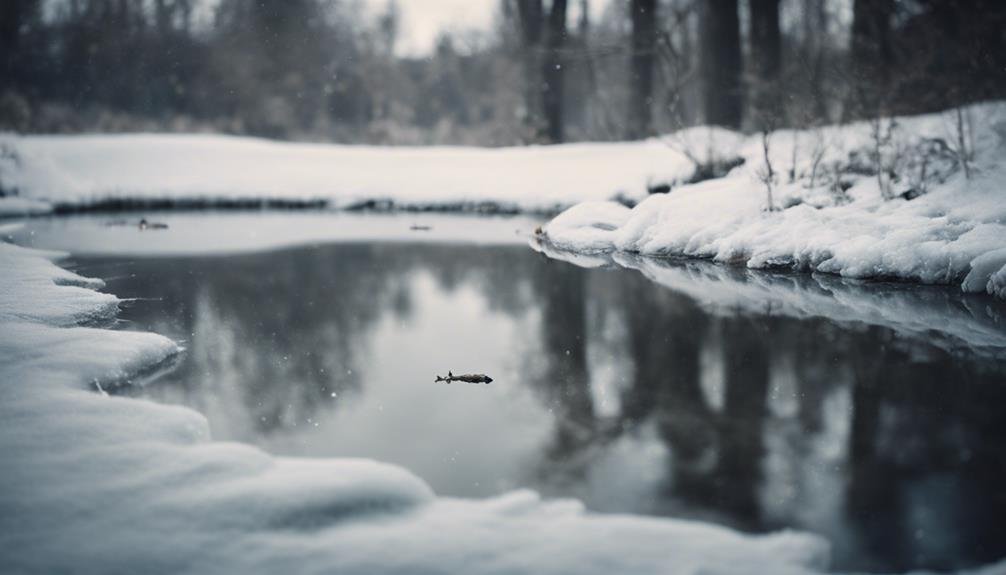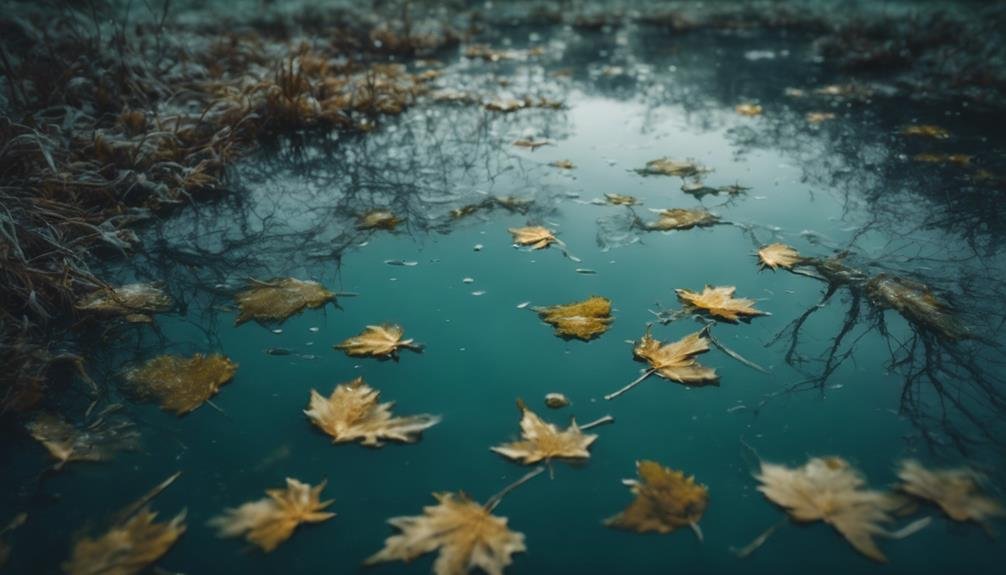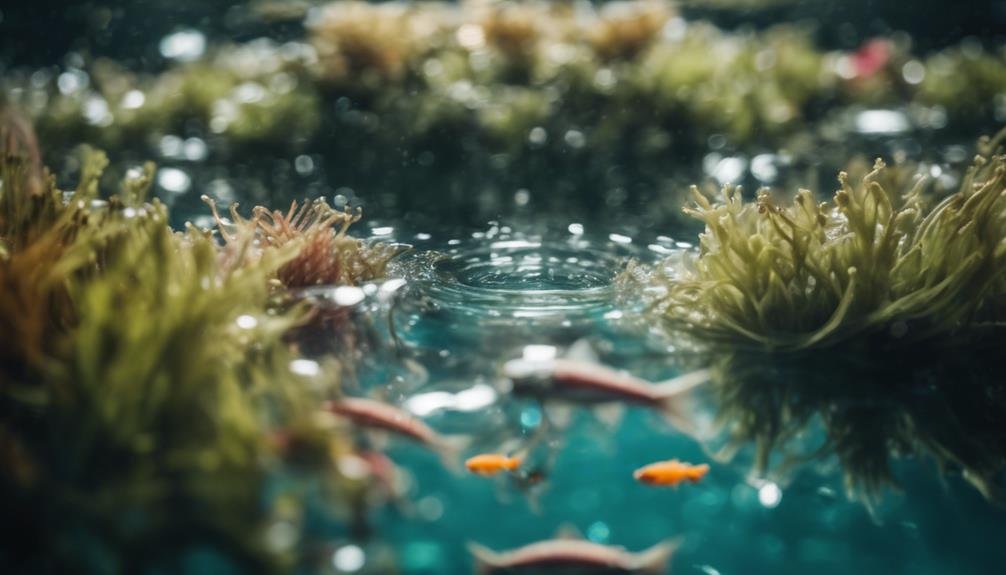To ensure our pond fish stay safe in the winter, it's crucial to regulate the water temperature using submersible deicers or heaters. These devices help prevent the water from freezing completely, ensuring the fish have access to oxygen.
Some of the links in this article may be affiliate links. If you make a purchase through these links, we may earn a small commission at no extra cost to you. Thank you.
Additionally, installing diffusers or aerators promotes gas exchange and prevents the water from stratifying, which can be deadly for the fish. Creating shelters, such as submerged logs or artificial caves with hardy plants, provides a safe refuge for the fish during the colder months.
Adjusting the fish's diet to a low-protein option every few days is important as their metabolisms slow down in the winter. Monitoring the thickness of the ice, clearing any hazards, and protecting the fish from predators are essential steps to take. Regularly maintaining filters is also crucial for ensuring healthy water circulation in the pond.
While these measures lay a strong foundation for keeping pond fish safe during winter, exploring additional preparations and investing in quality products can further enhance the well-being of our fish year-round. By implementing these strategies, our fish can thrive even in the coldest months.
Temperature Regulation
Protecting pond fish in winter requires maintaining a stable water temperature to prevent freezing or sudden fluctuations. One effective solution is using a submersible deicer or pond heater to keep a small section of water open, allowing harmful gases to escape and oxygen to enter, ensuring the fish can breathe comfortably.
It is crucial to minimize disturbances in the pond during winter to avoid stirring up debris and oxygen-depleting bacteria. Consider adding an aerator or water pump to keep the water circulating with oxygen-rich surface water, preventing stagnation and supporting fish health.
Regularly monitoring the water temperature is essential to ensure it stays between 33-65°F (0.5-18°C). If temperatures drop too low, temporary relocation of fish to an indoor aquarium or insulating the pond with floating insulation discs can help maintain stable conditions until spring arrives.
Taking these steps will help safeguard the well-being of pond fish during the winter months.
Aeration Techniques
To ensure the survival of fish during winter, it's crucial to maintain high oxygen levels in the pond by regularly aerating it. This can be achieved by installing a diffuser system or using an aerator to circulate the water and enhance oxygen absorption.
By doing so, we can prevent the formation of deadly stratification, where colder, oxygen-depleted water settles at the bottom of the pond.
If the pond is too small for a diffuser system, an alternative method is to use a pump and tubing to spray water onto the surface. This allows the water to capture oxygen before it sinks down. Another option is to create a breathing hole in the ice by floating a sealed container filled with a non-toxic salt solution. As the water freezes around the container, we can remove it to reveal the opening.
In extremely cold conditions, it's advisable to place a secure de-icer near the aerator opening to prevent the hole from freezing over. However, caution must be exercised with de-icers to avoid creating unsuitable conditions if used excessively.
Regularly monitoring oxygen levels with a test kit enables us to adjust aeration as necessary to maintain optimal fish health.
Shelter Provisions

Setting up shelters is crucial for protecting fish during harsh winter conditions. Providing shelters like submerged logs, overhanging plants, or artificial caves made from materials such as plastic pipes or terra-cotta pots gives fish safe hiding spots to conserve energy in the cold months. These shelters should have small openings for fish to swim through but be inaccessible to predators.
Placing partially submerged logs, rocks, or upside-down plastic crates near the deepest part of the pond allows fish to gather underneath for protection. Additionally, shelters help insulate the pond bottom, preventing it from freezing solid.
Simple and effective shelters can be made by anchoring evergreen boughs to the pond's edge or bottom, creating shaded areas and hiding spots for fish. Hardy plants like water lilies and cattails serve as winter refuges by trapping warmth and oxygen near their roots.
Diet Adjustments
In addition to providing shelter, adjusting the diet of pond fish is crucial for their survival in winter. During colder months, when fish are less active and have slower metabolisms, it's important to decrease their food intake and switch to a high-quality, low-protein diet. Overfeeding can lead to excess waste in the pond, harming water quality and the fish's health.
To prevent this, feed them every few days, offering only what they can consume in a few minutes and promptly removing any uneaten food.
When the water temperature drops below 50°F (10°C), the fish's digestion slows down significantly. At this point, it's best to stop feeding them until spring when temperatures rise again. Fish will naturally reduce their food intake and enter a semi-dormant state to conserve energy during the harsh winter conditions.
Water Deicers

In order to keep the pond from freezing completely, which could harm the fish by cutting off their oxygen supply, we'll need a water deicer. These devices help by creating a small hole in the ice, allowing for proper gas exchange and preventing stagnation.
There are different types of water deicers available, such as floating deicers, submersible deicers, and deicer rings.
Floating deicers sit on the water's surface and use a heating element to melt a hole in the ice, ensuring oxygen flow. Submersible deicers are placed underwater and work by circulating warm water to prevent ice from forming. Deicer rings are placed around the pond's edge, creating an ice-free area for essential gas exchange.
When selecting a deicer, it's crucial to consider the size of the pond and the severity of winter conditions. Larger ponds or harsh winters may require more powerful deicers to maintain a sufficient opening. Following the manufacturer's instructions for installation and safety is key.
Regular monitoring of the deicer and clearing any ice buildup around the opening is also important. By choosing the right water deicer, we can ensure that our pond fish have continuous access to the oxygen they need during the winter season.
Ice Monitoring
Monitoring the ice is crucial to keep our pond fish safe in winter.
It's important to regularly check the ice thickness to ensure it's safe for our aquatic friends.
By keeping track of the ice depth, we can take necessary steps to protect our fish from any potential dangers.
Unsafe Ice Hazards
Keeping a close eye on the frozen pond surface is crucial to protect our fish during the winter months. It's important to be aware of potential dangers posed by the ice. These include thin ice that can crack and trap fish in cold water, sharp edges that may harm fish, debris like branches that can injure or even kill fish, unstable ice layers caused by melting and refreezing, and snow buildup that blocks sunlight and oxygen exchange.
Regularly checking the ice for these hazards allows us to take quick action to prevent harm. Clearing away snow, debris, and unstable ice, as well as reinforcing thin areas with boards or foam, can help keep our fish safe.
Monitoring Ice Thickness
Keeping an eye on potential dangers is important, but regularly checking ice thickness is essential to protect our aquatic friends.
It's recommended to inspect the ice every few days, especially after temperature changes or heavy snow. To measure the thickness, drill a hole with an auger or ice pick, then use a ruler or dowel to determine the depth.
For safety, aim for a minimum of 4 inches of solid, clear ice before walking on the pond. If you plan to skate or drive on the ice, ensure it's at least 5 inches thick. Avoid cloudy or cracked ice, as it may not be safe.
Marking the thickest areas with colorful poles or flags can help identify the safest paths on the frozen surface. Keeping detailed records of measurements will assist in tracking ice thickness changes over time and planning for winter pond maintenance.
Water Quality

Taking care of water quality is crucial for the survival of pond fish during the winter season. Poor water conditions can be harmful, even fatal, for fish, so it's essential to stay alert.
As winter nears, several factors can impact water quality:
- Reduced oxygen levels from ice covering the pond
- The build-up of toxic substances from decaying plants
- Slower biological processes due to lower water temperatures
- A lack of plant growth to absorb nutrients and waste
- The potential for ice dams obstructing water circulation
These issues can quickly deteriorate the pond environment, putting the fish at risk.
Regular testing and adjustments are necessary to maintain optimal oxygen levels, pH balance, ammonia, nitrite levels, and water temperatures. Aeration devices, water treatments, partial water changes, and heaters may be required to ensure a healthy environment for the fish.
Neglecting water quality during the winter can have serious consequences for the fish. By monitoring closely and taking action when needed, we can help our fish thrive until the arrival of spring.
Predator Protection
In addition to maintaining water quality, it's crucial to protect pond fish from predators during the harsh winter conditions. Animals like raccoons, herons, and even household pets may see our ponds as an easy source of food when other options are scarce. To deter these unwelcome visitors, consider installing netting or fencing around the pond to keep predators out. Make sure the mesh size is small enough to prevent entry by potential threats.
Keeping an area of open water can also help safeguard our fish. Predators often target ponds covered in ice, assuming the fish are trapped and easy to catch. Using a deicer or aerator to prevent a section of water from freezing over provides a safe space for our fish to avoid becoming prey.
Furthermore, it's essential to eliminate any potential hiding spots near the pond's edge. Overhanging branches, tall grasses, or dense shrubbery can give predators a place to hide and ambush fish. Keeping the area around the pond trimmed and clear removes these hiding spots, enhancing the safety of the pond's inhabitants during the winter months.
Filtration Maintenance

During the winter season, while protecting our fish from predators is crucial, it's equally important to maintain our pond's filtration system for their well-being. The filter plays a vital role in keeping the water clean and full of oxygen, creating a healthy habitat for our fish.
Neglecting filter maintenance can result in harmful effects such as toxic ammonia buildup, cloudy water, oxygen depletion, excessive algae growth, and even illness or death among the fish.
Regular inspection and upkeep of the filter are necessary tasks. This includes cleaning the filter media, checking water flow, and possibly using a deicer to prevent freezing.
Especially in the colder winter temperatures when fish metabolism slows down, the filter becomes essential in circulating and purifying the water, removing waste, and adding oxygen back into the pond.
Early Spring Preparations
As the weather gets warmer, it's time to get our pond ready for spring. The first step is to check the water temperature and remove any remaining ice to ensure the pond thaws properly. It's crucial to keep an eye on oxygen levels as well, as low oxygen levels can harm or even kill our fish as the water warms up.
To prepare for the changing season, we should consider using a pond thermometer to accurately measure the water temperature. This will help us determine when it's safe to start reintroducing fish and plants back into the pond. Additionally, investing in a de-icer can help prevent ice build-up and ensure a smooth transition into spring.
Monitoring oxygen levels is essential for the health of our pond ecosystem. Aeration devices such as air pumps and diffusers can help increase oxygen levels and prevent fish stress. Regularly testing the water quality and considering adding beneficial bacteria can also promote a healthy environment for our aquatic friends.
Water Temperature Check
As winter fades away, it's crucial to monitor the pond water temperature before reintroducing our fish. Gradual warming signals the right time to move our aquatic friends back outside. However, sudden temperature shifts can harm these delicate creatures, so we must proceed with caution.
While eagerly anticipating their return, let's appreciate the deep connection we share with our finned companions. Watching their graceful movements brings a sense of peace, and creating a thriving ecosystem for them is truly rewarding. Their vibrant colors and unique personalities never fail to bring us joy, and their calming presence has a therapeutic effect on us. These fish also serve as a reminder of our connection to nature in the midst of our urban lives.
To ensure a smooth transition, we'll slowly adjust the pond water temperature to match what our fish are accustomed to indoors. This gradual process minimizes stress and reduces the risk of health issues. With patience and attention, our fish will soon be back in the pond, adding life and color to our outdoor sanctuary.
Ice Removal Strategy
As spring approaches, it's crucial to gently remove any remaining ice from the pond's surface. As the temperatures consistently rise above freezing, it's time to carefully clear away the layer of ice that has formed during the winter months. This process should be done gradually to avoid startling the fish or causing damage to the pond lining.
Our method involves starting with a small hole in the ice using a de-icer or by gently chipping away at it. Each day, we gradually expand this hole until the entire surface is free of ice. Rapid ice removal can shock the fish with sudden temperature changes, so we take our time to ensure their well-being.
As more of the pond's surface becomes ice-free, it's important to reintroduce oxygen by turning on aerators or fountains. Since the fish have been in a state of low energy conservation throughout the winter, reintroducing oxygen slowly allows their metabolism to adjust safely.
Oxygen Level Monitoring
As we remove ice gradually from the pond, we closely monitor oxygen levels to ensure the safety of our fish during winter. Low oxygen can be harmful to them, so it's crucial to regularly check and maintain adequate levels.
We use specialized testing kits or dissolved oxygen meters for accurate measurements. If levels drop too low, we take immediate action by installing an aeration system, creating openings in the ice for gas exchange, adding a water pump for circulation, or partially draining and refilling with fresh, oxygenated water.
In extreme cases, we may temporarily relocate fish to a holding tank to ensure their survival. These interventions provide the necessary oxygen for our fish until natural aeration resumes in spring. Our vigilance in monitoring oxygen levels is essential for a healthy pond ecosystem throughout the winter months.
Conclusion
As winter gradually fades away, we must remain vigilant in caring for our pond fish.
It's crucial to constantly monitor the water conditions, ensuring that the oxygen levels and temperatures are optimal for the well-being of our aquatic friends.
By being well-prepared and taking prompt action when needed, we can safely guide them through this period of transition and witness their vibrant return to the revitalized pond environment.

